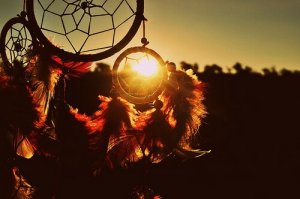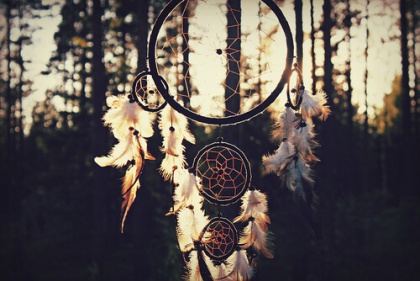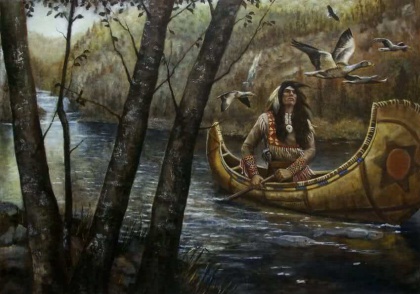The Legend of the Dreamcatcher

Let your good memories be caught in the web, and let the bad ones vanish through the hole in the middle.
Dreamcatchers are instruments of power according to shamanic medicine, whose origin dates back to Native American tribes. The hoop represents the circle of life, and the net represents the dreams that we weave in our sleep, in our soul, and in the movement generated by daily activity. In the middle of the net, there’s a mysterious empty space that serves an important purpose.
According to tradition, these objects help us to keep our good ideas and pleasant dreams with us, and also to protect the owner. Our dreams are influenced by good and bad energies; the latter are trapped in the net and disappear through the center hole when the sun rises.

Dreamcatchers take their name from the Ojibwe word “asabikeshiinh,” which means “spider,” although they were also known by the name “bawaajige nagwaagan,” or “trapper of dreams.”
Traditionally, the Ojibwe people make dreamcatchers by tying strands of willow around a 9-centimeter ring or teardrop, resulting in a net similar to a spider web, made of fibers that they would dye red.
These objects started to become commercialized by the Ojibwe in the sixties, which brought them criticism from other tribes for desecrating their meaning. This makes sense, because as commercial products, they’re made and sold without going through the magical and mystical process of energization, thus losing their essence and becoming nothing more than a mere decoration.
Thanks to commercialization, belief in dreamcatchers has expanded immensely in the last few years. However, most of us don’t know the intriguing legend behind them…

The legend of the dreamcatcher
The legend says that there was a spider woman named Asibikaashi who took care of the people of Earth. She watched over every creature in the world, bending over children’s cribs and beds while she wove a thin, delicate, and strong web that was capable of trapping everything bad in its threads and making it vanish at dawn.
When her people dispersed throughout North America, it became very hard for her to care for all the children, so the mothers and grandmothers had to weave their own magical webs that would trap bad dreams and nightmares, protecting their children.
The ancient Ojibwe legend about dreamcatchers says that all dreams pass through the web, which filters out the good dreams through the feathers until they reach us. The bad dreams, however, are trapped in the web and die by sunrise.
However, for the Lakota people of the Sioux tribe in North America, dreamcatchers work differently. For them, nightmares pass through the web, while the dreams remain trapped in the threads and slide through the feathers towards the person who is sleeping.
The bad is blocked and destroyed, and the good stays with us
There are people who tell this a little differently, understanding the word “dreams” as aspirations, desires, or wishes. Therefore, dreamcatchers can serve whatever purpose we want them to.
The truth is that we can’t ensure that bad dreams, energies, or spirits will be warded off or not, but it is peaceful to get in touch with Native American culture. This culture has filled us with ancient knowledge and traditions that we should fight to maintain as faithfully as possible, because we owe a large part of our wisdom to them.
Let your good memories be caught in the web, and let the bad ones vanish through the hole in the middle.
Dreamcatchers are instruments of power according to shamanic medicine, whose origin dates back to Native American tribes. The hoop represents the circle of life, and the net represents the dreams that we weave in our sleep, in our soul, and in the movement generated by daily activity. In the middle of the net, there’s a mysterious empty space that serves an important purpose.
According to tradition, these objects help us to keep our good ideas and pleasant dreams with us, and also to protect the owner. Our dreams are influenced by good and bad energies; the latter are trapped in the net and disappear through the center hole when the sun rises.

Dreamcatchers take their name from the Ojibwe word “asabikeshiinh,” which means “spider,” although they were also known by the name “bawaajige nagwaagan,” or “trapper of dreams.”
Traditionally, the Ojibwe people make dreamcatchers by tying strands of willow around a 9-centimeter ring or teardrop, resulting in a net similar to a spider web, made of fibers that they would dye red.
These objects started to become commercialized by the Ojibwe in the sixties, which brought them criticism from other tribes for desecrating their meaning. This makes sense, because as commercial products, they’re made and sold without going through the magical and mystical process of energization, thus losing their essence and becoming nothing more than a mere decoration.
Thanks to commercialization, belief in dreamcatchers has expanded immensely in the last few years. However, most of us don’t know the intriguing legend behind them…

The legend of the dreamcatcher
The legend says that there was a spider woman named Asibikaashi who took care of the people of Earth. She watched over every creature in the world, bending over children’s cribs and beds while she wove a thin, delicate, and strong web that was capable of trapping everything bad in its threads and making it vanish at dawn.
When her people dispersed throughout North America, it became very hard for her to care for all the children, so the mothers and grandmothers had to weave their own magical webs that would trap bad dreams and nightmares, protecting their children.
The ancient Ojibwe legend about dreamcatchers says that all dreams pass through the web, which filters out the good dreams through the feathers until they reach us. The bad dreams, however, are trapped in the web and die by sunrise.
However, for the Lakota people of the Sioux tribe in North America, dreamcatchers work differently. For them, nightmares pass through the web, while the dreams remain trapped in the threads and slide through the feathers towards the person who is sleeping.
The bad is blocked and destroyed, and the good stays with us
There are people who tell this a little differently, understanding the word “dreams” as aspirations, desires, or wishes. Therefore, dreamcatchers can serve whatever purpose we want them to.
The truth is that we can’t ensure that bad dreams, energies, or spirits will be warded off or not, but it is peaceful to get in touch with Native American culture. This culture has filled us with ancient knowledge and traditions that we should fight to maintain as faithfully as possible, because we owe a large part of our wisdom to them.
This text is provided for informational purposes only and does not replace consultation with a professional. If in doubt, consult your specialist.








